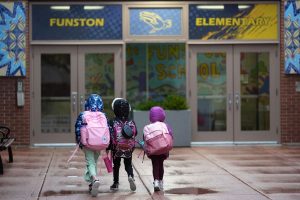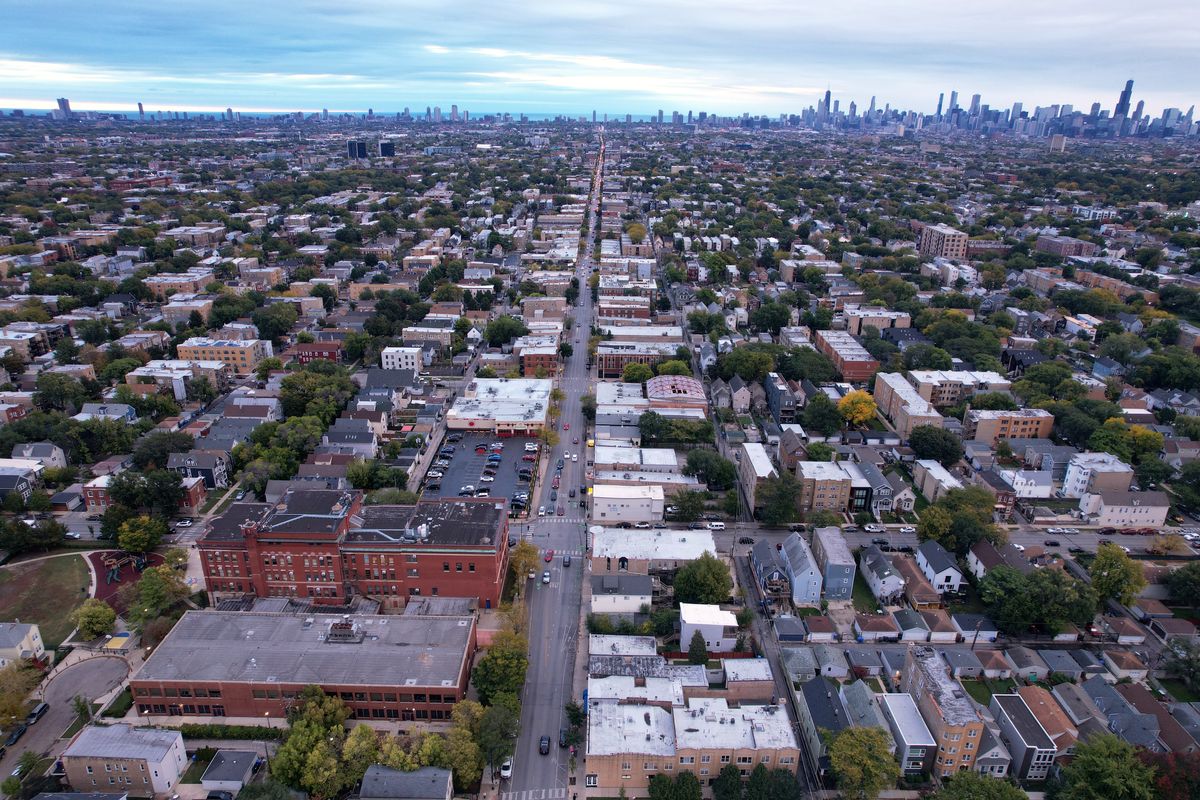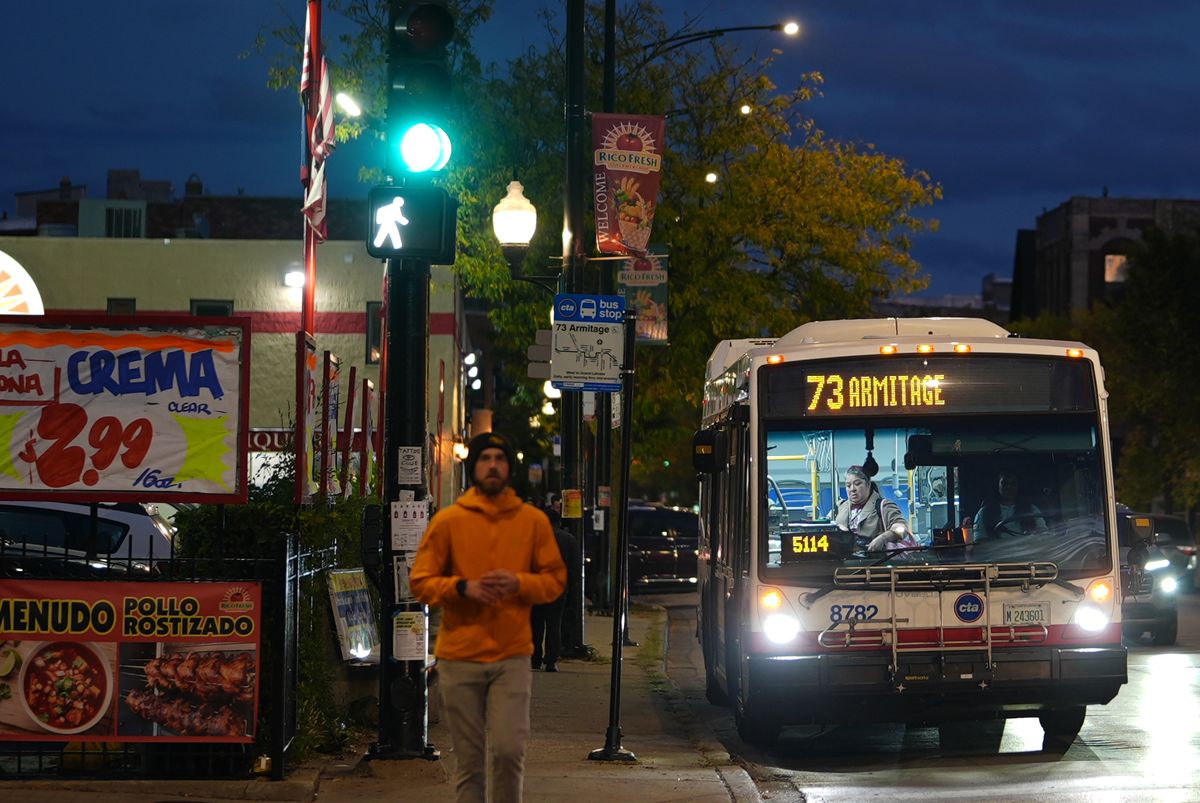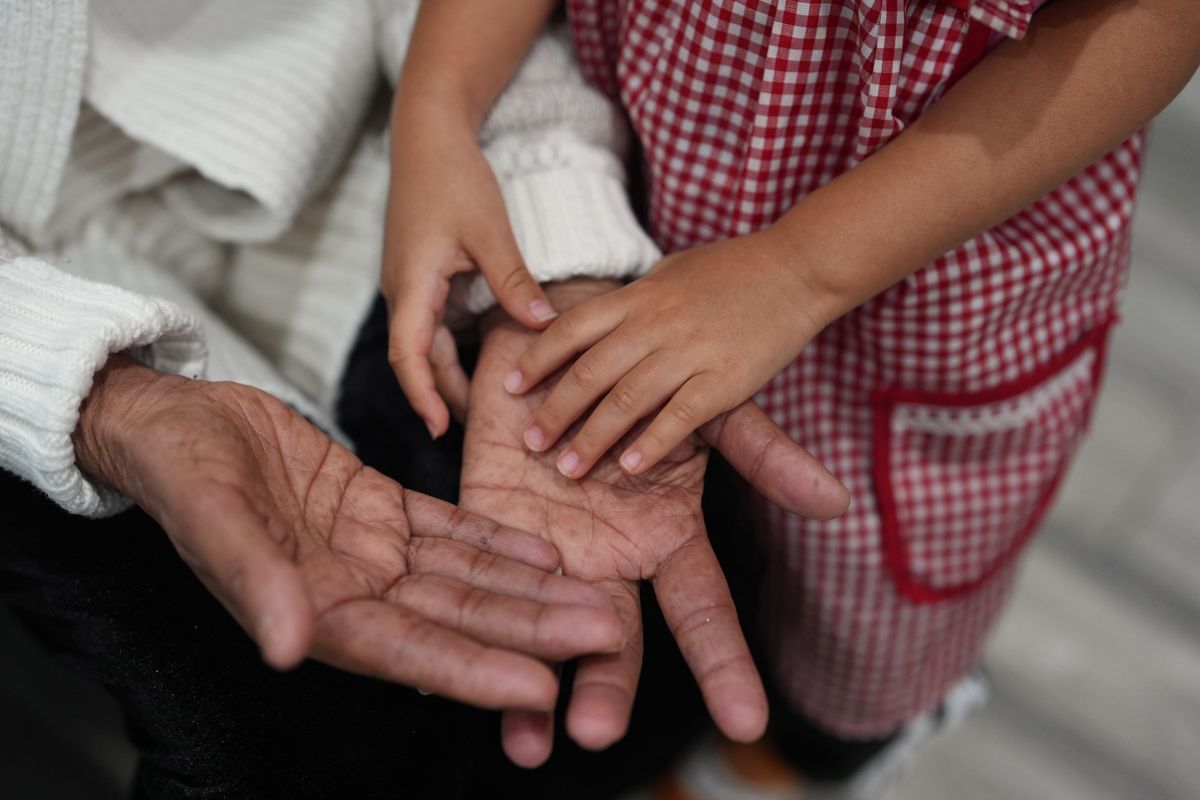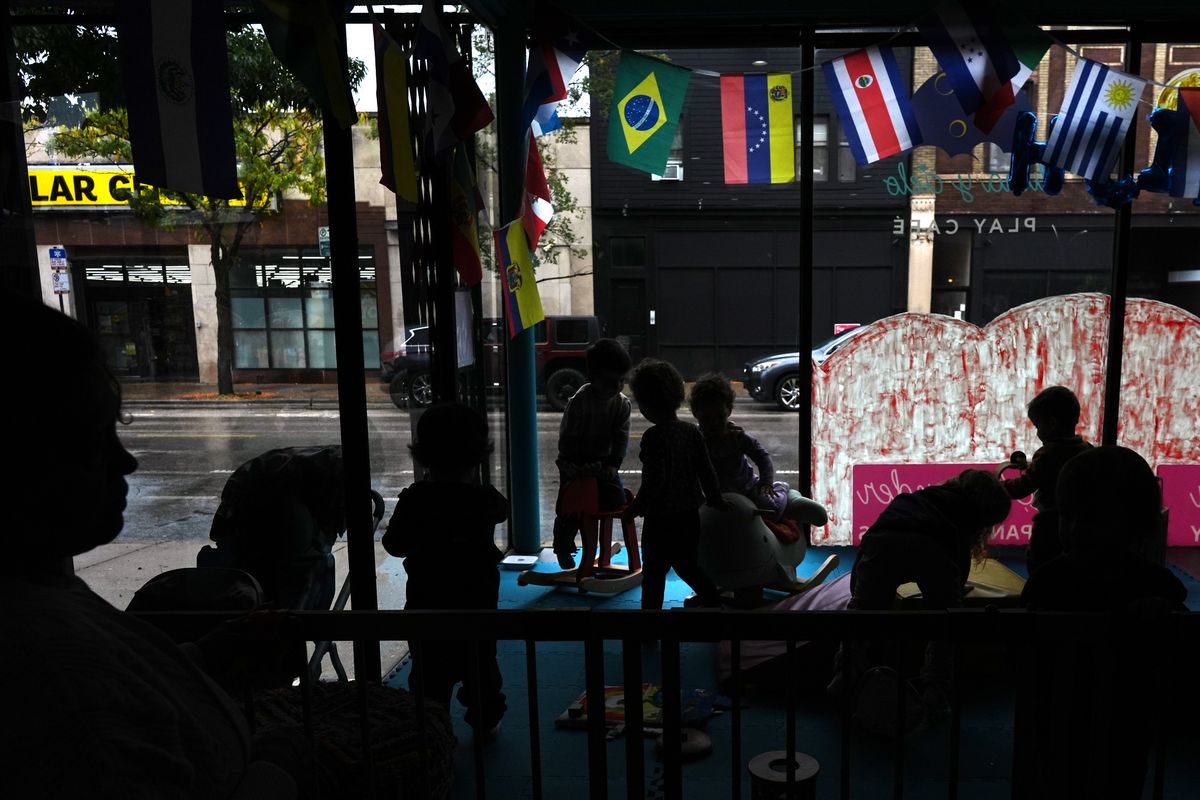CHICAGO (AP) — The 2-year-old boy was so frightened, he stuttered.
“Mommy, mommy, mommy,” he repeated, clinging to her.
His mother, Molly Kucich, had been grocery shopping when her husband called, panicking. She heard “immigration raid.” Then: “tear gas.”
She abandoned her grocery cart and drove as fast as she could to her toddler and his 14-month-old brother, who, on that warm October Friday, were among the hundreds of Chicago children caught suddenly in the turmoil of the Trump administration’s immigration crackdown.
Parents, teachers and caregivers have been grappling ever since with how to explain to children what they’d seen: how much to tell them so they know enough to stay safe, but not too much to rob them of their childhood. A toddler shouldn’t know what a tear gas canister is, Kucich said.
“I don’t know how to explain this to my kids.”
Children were playing on the monkey bars outside Funston Elementary School just before noon on Oct. 3 when a white SUV rolled down their street in Logan Square, a historically Hispanic neighborhood that’s been steadily gentrifying for years. Cars followed behind it, drivers laying on their horns to alert neighbors that these were federal agents. A scooter pulled in front of the SUV, trying to block it in. There were no mass protests; some teachers walking to lunch initially didn’t realize what was happening.
Suddenly, tear gas canisters flew from the window of the SUV.
The cloud of gas rose, first white, then green, and the street exploded into pandemonium. Some people ran. Others shouted at agents to leave. Sirens screamed toward them. Parents blew through stop signs and drove on curbs to reach their children.
Kucich’s son was a half-block away, having lunch in the window of Luna y Cielo Play Cafe, where children learn Spanish as they play with pretend food and toy cars. His nanny takes him there most days. He made his best friends at the cafe, and his little brother took his first steps there.
Owner Vanessa Aguirre-Ávalos ran outside to see what was happening, as the children’s nannies hustled them to a back room. Aguirre-Ávalos is a citizen; the nannies, Hispanic grandmothers, are citizens or are legally allowed to work in the U.S.
Still, they were terrified. One begged Aguirre-Ávalos: If they take me, please make sure the children get home safe.
The SUV eventually drove away, the cloud of smoke cleared, and parents arrived. “What’s happening?” a girl cried, over and over.
Kucich’s son, who is white, now worries about his nanny, a U.S. citizen from Guatemala. He asks where she is and when she’s coming. He jumps at the sound of sirens. His mother called their pediatrician for a therapist referral.
Andrea Soria, whose daughter plays at Luna y Cielo, overheard her 6-year-old whisper to her dolls: “We have to be good or ICE will get us,” referring to U.S. Immigration and Customs Enforcement.
“These kids are traumatized,” Aguirre-Ávalos said. “Even if ICE stops doing what they’re doing right now, people are going to be traumatized. The damage is already done.”
‘I had to act like nothing was wrong’
It was a beautiful Friday, so fifth grade teacher Liza Oliva-Perez walked to the grocery store across the street for lunch.
She noticed a helicopter circling, then the SUV and its tail of honking cars.
That morning, another teacher gave her a whistle, with instructions to blow it if immigration agents were in the neighborhood.
Oliva-Perez fumbled the whistle to her lips. Just then, the SUV’s window rolled down and she saw a masked man inside throw a tear gas canister.
“I couldn’t fathom that was happening,” said Oliva-Perez. Then he threw another, this time in her direction.
The Department of Homeland Security said in a statement that Border Patrol agents were “impeded by protesters” during a targeted enforcement operation in which one man was arrested.
The Chicago crackdown, dubbed “Operation Midway Blitz,” began in early September. Masked, armed agents in unmarked trucks patrol neighborhoods, and residents have protested in ways big and small against what they see as their city under siege. Agents stormed an apartment complex by helicopter in the middle of the night. They’ve detained U.S. citizens, including elected officials. An agent shot and wounded a woman who allegedly used her car to box them in. Protesters have been tear-gassed and shot with pepper bullets. President Donald Trump wants to deploy the National Guard.
DHS wrote that its agents are being terrorized: “Our brave officers are facing a surge in increase in assaults against them, inducing sniper attacks, cars being used as weapons on them, and assaults by rioters. This violence against law enforcement must END. We will not be deterred by rioters and protesters in keeping America safe.”
The statement said that in Logan Square, agents deployed tear gas along with pepper balls “after repeated vocal attempts to disperse the crowd.”
Oliva-Perez was feet away on the sidewalk and didn’t hear them say anything. Videos show cars and the scooter trying to block the SUV, and a few pedestrians heckling the officers.
Oliva-Perez ran toward the school, yelling at staff to get the children inside.
“It really shook me,” she said. “Here I am, a U.S. citizen, a teacher, and I got treated like a common criminal.”
She was shaking when she got to her classroom of 25 students, who wanted to know what just happened. All of them are Hispanic. She knows they are having agonizing conversations at home — who they’ll call if their parents disappear, where they’ll go. Oliva-Perez became a teacher six years ago, after her daughter died by suicide at 16 years old. She wanted to help kids feel loved and safe. She never had a harder time than on that afternoon.
“I had to act like nothing was wrong,” she said. “I don’t want them to be like, if Ms. Oliva is scared then I’m going to be scared too.”
She and the other teachers spent the afternoon telling the children that everything was fine. But each dreaded the bell at the end of the day. They’d have to lead the students outside, and they didn’t know what would be waiting: Masked men? More tear gas?
First grade teacher Maria Heavener spread the word in community group chats that the school needed help.
When the final bell rang, she walked her students outside. In every direction, neighbors lined the sidewalk, dozens of them. There were people who’d never considered themselves activists, or even particularly political, standing there, enraged, scanning the streets for unmarked SUVs and masked men. They signed up to come back every morning and afternoon.
“You don’t mess with the kids. You don’t go near the schools,” Heavener said. “Whatever your agenda is, that feels like it’s crossing a lot of lines.”
‘Our skin color defines us’
Two little boys walking by Evelyn Medina’s gift shop next door to the school gripped each other so tightly their fingers dug into each other’s hands.
“They were so scared,” said Medina, who cries when she thinks about how they looked leaving school that day. “It was really hard to see, imagining what’s going on in their little minds.”
Medina, a 43-year-old citizen, understands the fear these children face: She came to the U.S. from Mexico at age 8. As a child, she worried someone would take her parents away.
She noticed people picking up multiple children that day, for their friends and neighbors who were too afraid to leave their houses. One parent packed seven children into a minivan. A 13-year-old girl wept when she saw a neighbor there to get her. Her mother usually comes for her, but not that day.
When that girl got home, she told her mother she thought the house might be empty, that agents might have been there and taken her away.
Her mother does not have permanent legal status and asked that her name not be used out of fear of being targeted for deportation. Her greatest fear is being separated from her children.
This fear coursing through this community is no longer reserved for families lacking permanent legal status.
One mother, whose 12-year-old son was in the school that day, now jolts awake each morning at 4 a.m., her head pounding, her heart racing. She checks social media frequently for reports of people spotting Border Patrol or ICE: another tear gassing; another raid; a 15-year-boy, an American citizen, detained.
She and her son are citizens, but she asked that only her first name, Ava, be used because she’s scared that their citizenship won’t matter.
“Our skin color defines us,” she said.
Her son cries constantly, “I don’t want to lose my grandparents.”
He’s offered to get them groceries so they can stay inside. She’s struggling with how to balance letting him help without burdening him and without making him grow up too quickly.
“Losing them, it would forever break him apart,” she said. “His question is always: why? Why?
“I don’t know why.”
‘We’ll always be targeted’
Vanessa Aguirre-Ávalos keeps the door locked now at Luna y Cielo, and she wears her whistle like a necklace, always at the ready.
When she hears a car horn honk, she panics. Is it happening again?
That day, she ran in and out of her shop, bringing milk and vinegar to help people clean the tear gas and pepper residue from their faces. She coughed for two days.
Her neighborhood has become a symbol for what happens when children get caught in the fray of aggressive, sometimes violent federal actions. Randi Weingarten, the president of the American Federation of Teachers, spoke outside of the school a few days later: “In order to educate children, we have to protect them. We have to create a safe and welcoming environment. That is who we are as educators. That is who educators have always been.”
Now, every utility pole is plastered with anti-ICE stickers and instructions for what to do if detained. “ICE TEAR GASSED THIS NEIGHBORHOOD,” reads one. “No one is safe unless we all are.”
Aguirre-Ávalos, who grew up in this neighborhood, was born in Texas to a mother from Mexico, and she’s considering moving there. It’s hard for her to imagine a future in Chicago or anywhere else the U.S. for her children, an 8-year-old son and 14-year-old daughter.
“They don’t want us here,” Aguirre-Ávalos said of her own government. “We’ll always be targeted.”
She opened Luna y Cielo two years ago to be a fun place for children to learn Spanish, to help the next generation learn to love the language. Her business is suffering now; she’s not sure she can make this month’s rent.
People are staying inside, their curtains drawn. Playgrounds are quiet. The vendor who sold ice cream on her corner doesn’t come out anymore. Everyone is scared.
She scheduled a guided journaling session with parents. She’s bringing in a Spanish-speaking therapist to talk to the nannies.
‘This is not living’
One of the nannies, who watches two young sisters, doesn’t wear pajamas to bed anymore. She sleeps in her clothes, unable to get a full night’s rest.
“This is not a life. This is not living,” she said.
She wakes up every morning by 4 a.m., and she drops to her knees to pray.
She is the grandmother of five and great-grandmother to two, and legally allowed to work in the U.S. She spoke on the condition that her name not be used because she worries about what could happen to her and her family, as well as the 2-year-old and 3-year-old she cares for.
“If I’m walking with them and they grab me, what do I do?” she asked. “I can’t leave them alone.”
She has not been this afraid in 31 years, since she fled from El Salvador to escape war and violence.
“We already lived this war once,” said her friend, the nanny who looks after two brothers.
That nanny left Guatemala 33 years ago, also to escape war and the constant threat of danger.
She’s a U.S. citizen and always carries her passport now. She asked that she not be named because some of her relatives aren’t legal residents. She helps pay rent and buy groceries for a second family because they’re too afraid to go to work.
She’s scared that immigration agents could grab her when she has the boys. She didn’t want them to see her cry on Oct. 3. But once the boys were home, she got in her car and wept.
She drove to her church, lit a candle and prayed.
She asked God to protect all the immigrants, and all the children.
___
Associated Press reporter Sophia Tareen, photographer Rebecca Blackwell and videographer Laura Bargfeld contributed to this report.
___
The AP’s education coverage receives financial support from multiple private foundations. AP is solely responsible for all content. Find AP’s standards for working with philanthropies, a list of supporters and funded coverage areas at AP.org.
By CLAIRE GALOFARO
Associated Press

